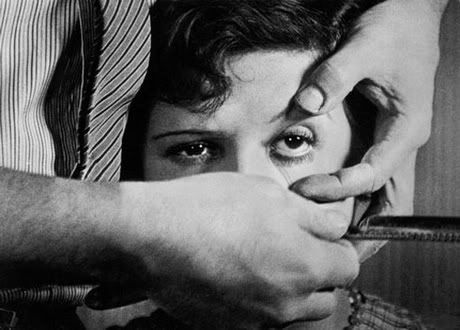I love Un Chien Andalou. I think it's so brilliant, and I think it's because the filmmakers (surrealist artists Salvador Dali and Luis Bunuel) have used conventional Hollywood narrative structure and applied it to a 'meaningless' set of images. My dear, dear friend Tori visited the Dali exhibit in Melbourne and found me a quote from Dali about the film, and though I can't remember it verbatim, it was roughly that the film was a deliberate attempt to subvert meaning, the images were put together in order so as to be completely meaningless.
While this is an interesting aim, it will never work. Film, much like all other art, cannot be meaningless. My old friend (I have a lot of friends, don't I?) Roland Barthes, whom I like to call Barty, hits the nail on the head in Death of the Author when he says that the death of the author means the birth of the reader. Meaning is instantly created whenever an artwork is received. As soon as someone looks at an artwork, they cannot help but create meaning for themselves.
I have watched Un Chien Andalou in three film courses; Genre Studies: The Horror Film, Screen Culture, and now Alternative Histories of Film and Video. The last two consider the film to be an art film, part of the surrealist movement's attempt to subvert meaning and narrative structure. But the first viewing hinted at a meaning beyond that.
The most memorable moment in this film is in the opening sequence. A barber (played by Bunuel), sharpens his razor and disturbed, he looks out at the night sky, and we see a full moon. He goes back inside and holds a woman's face in place. Then holds her eyes open. She doesn't struggle. I think you know what's about to happen.
We cut to a shot of the moon being slashed by a cloud, and we think this is the symbol for the woman's eye and the barber's razor. Nup. Merely a break - we cut back to the razor slicing the woman's eye open.
When I watched this in the horror course, people actually cried out in, well, horror, as it happens. People who laughed at me when I said the Blair Witch Project was truly scary because of the absence of a monster, while these hipsters all said the same film (The Omen. Pft!). I, meanwhile, did not cry out. I was fascinated. I hadn't seen anything like it before. And the fact that for all intents and purposes, it was real (Bunuel slices the eye of a dead sheep - not a lady), made it even more extraordinary, that a film made so long ago had the power to make people squirm.
In the seminar on Tuesday night, for Alternative Histories of Film and Video, we discussed how and why these 'old' art films may still have the power to shock people. We hinted at why, but never really talked about it in any great detail. And it's so important! We talk about it alllll the time in film and yet all we could say about it is that it's a fragile part of the body and we don't like seeing it damaged.
It's all about the eyes, my friend. In horror, the image of seeing an eye destroyed is pretty common. Bits of the body being cut up in general, in fact. So much of horror deals with the body - the uncanny (something familiar becoming unfamiliar and the ensuing sensation that produces), the abject (seeing parts of ourself that disgust us), and the unseen elements of death becoming seen) are all associated with images of the body destroyed in horror. So on one level, horror is shocking because we are shown exactly how fragile the body is and how it can be torn apart. So, yes, the people in my class that raised this point are quite correct.
But I think in the case of the eye, it's more complicated than that. Another tutor reminded us last week that we are a predominantly visual culture, that is, we watch more television and cinema than we read books. Screen Culture discussed the idea that we are constantly engaging with the world through a screen. The eye is the primary way we process information. Seeing it shut down makes us feel vulnerable because having our eye damaged, whether through illness, childhood accidents, altercations with Uma Thurman, or by having it sliced open, would mean that we would instantly lose our way of processing information.
We lose our way of identifying with characters. The camera is often referred to as the eye. In many horror films our eyes are restricted to the eyes of a killer, but rather than identifying with them we feel disoriented because their vision is often obscured. In narrative films in general, however, we are encouraged to see the camera as the eye, allowing us to view other people in a new way, and without guilt, it's been suggested.
Hmm, why is that more complicated than seeing our fragile little peepers torn apart? Because it's our worst nightmare. Of course, being blind is not the end of things. Radio programs prove that we cannot process information and create meaning without using our eyes. However, it's the eye that is possibly the body part used the most in processing information and seeing our worst fears realised on film is shocking. And it will always be shocking.

